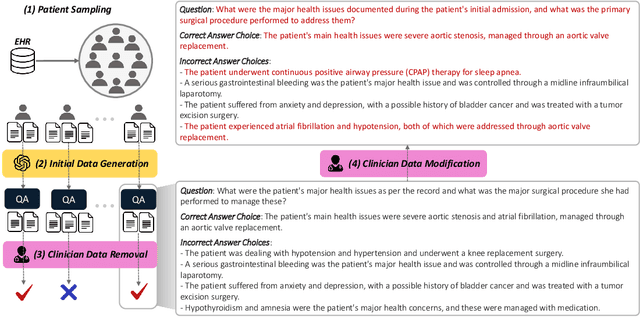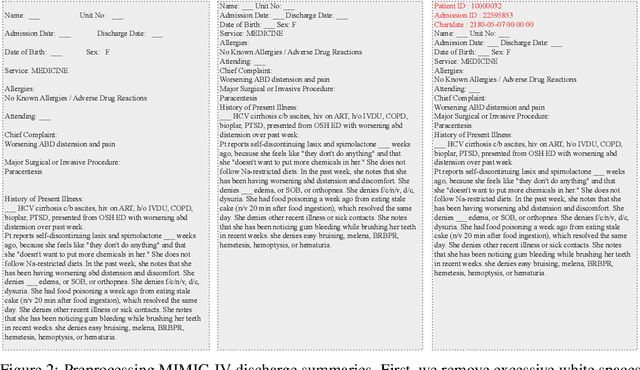Hangyul Yoon
Lunguage: A Benchmark for Structured and Sequential Chest X-ray Interpretation
May 27, 2025Abstract:Radiology reports convey detailed clinical observations and capture diagnostic reasoning that evolves over time. However, existing evaluation methods are limited to single-report settings and rely on coarse metrics that fail to capture fine-grained clinical semantics and temporal dependencies. We introduce LUNGUAGE,a benchmark dataset for structured radiology report generation that supports both single-report evaluation and longitudinal patient-level assessment across multiple studies. It contains 1,473 annotated chest X-ray reports, each reviewed by experts, and 80 of them contain longitudinal annotations to capture disease progression and inter-study intervals, also reviewed by experts. Using this benchmark, we develop a two-stage framework that transforms generated reports into fine-grained, schema-aligned structured representations, enabling longitudinal interpretation. We also propose LUNGUAGESCORE, an interpretable metric that compares structured outputs at the entity, relation, and attribute level while modeling temporal consistency across patient timelines. These contributions establish the first benchmark dataset, structuring framework, and evaluation metric for sequential radiology reporting, with empirical results demonstrating that LUNGUAGESCORE effectively supports structured report evaluation. The code is available at: https://github.com/SuperSupermoon/Lunguage
CXReasonBench: A Benchmark for Evaluating Structured Diagnostic Reasoning in Chest X-rays
May 23, 2025Abstract:Recent progress in Large Vision-Language Models (LVLMs) has enabled promising applications in medical tasks, such as report generation and visual question answering. However, existing benchmarks focus mainly on the final diagnostic answer, offering limited insight into whether models engage in clinically meaningful reasoning. To address this, we present CheXStruct and CXReasonBench, a structured pipeline and benchmark built on the publicly available MIMIC-CXR-JPG dataset. CheXStruct automatically derives a sequence of intermediate reasoning steps directly from chest X-rays, such as segmenting anatomical regions, deriving anatomical landmarks and diagnostic measurements, computing diagnostic indices, and applying clinical thresholds. CXReasonBench leverages this pipeline to evaluate whether models can perform clinically valid reasoning steps and to what extent they can learn from structured guidance, enabling fine-grained and transparent assessment of diagnostic reasoning. The benchmark comprises 18,988 QA pairs across 12 diagnostic tasks and 1,200 cases, each paired with up to 4 visual inputs, and supports multi-path, multi-stage evaluation including visual grounding via anatomical region selection and diagnostic measurements. Even the strongest of 10 evaluated LVLMs struggle with structured reasoning and generalization, often failing to link abstract knowledge with anatomically grounded visual interpretation. The code is available at https://github.com/ttumyche/CXReasonBench
Med-PerSAM: One-Shot Visual Prompt Tuning for Personalized Segment Anything Model in Medical Domain
Nov 25, 2024Abstract:Leveraging pre-trained models with tailored prompts for in-context learning has proven highly effective in NLP tasks. Building on this success, recent studies have applied a similar approach to the Segment Anything Model (SAM) within a ``one-shot" framework, where only a single reference image and its label are employed. However, these methods face limitations in the medical domain, primarily due to SAM's essential requirement for visual prompts and the over-reliance on pixel similarity for generating them. This dependency may lead to (1) inaccurate prompt generation and (2) clustering of point prompts, resulting in suboptimal outcomes. To address these challenges, we introduce \textbf{Med-PerSAM}, a novel and straightforward one-shot framework designed for the medical domain. Med-PerSAM uses only visual prompt engineering and eliminates the need for additional training of the pretrained SAM or human intervention, owing to our novel automated prompt generation process. By integrating our lightweight warping-based prompt tuning model with SAM, we enable the extraction and iterative refinement of visual prompts, enhancing the performance of the pre-trained SAM. This advancement is particularly meaningful in the medical domain, where creating visual prompts poses notable challenges for individuals lacking medical expertise. Our model outperforms various foundational models and previous SAM-based approaches across diverse 2D medical imaging datasets.
Data-Efficient Unsupervised Interpolation Without Any Intermediate Frame for 4D Medical Images
Apr 01, 2024



Abstract:4D medical images, which represent 3D images with temporal information, are crucial in clinical practice for capturing dynamic changes and monitoring long-term disease progression. However, acquiring 4D medical images poses challenges due to factors such as radiation exposure and imaging duration, necessitating a balance between achieving high temporal resolution and minimizing adverse effects. Given these circumstances, not only is data acquisition challenging, but increasing the frame rate for each dataset also proves difficult. To address this challenge, this paper proposes a simple yet effective Unsupervised Volumetric Interpolation framework, UVI-Net. This framework facilitates temporal interpolation without the need for any intermediate frames, distinguishing it from the majority of other existing unsupervised methods. Experiments on benchmark datasets demonstrate significant improvements across diverse evaluation metrics compared to unsupervised and supervised baselines. Remarkably, our approach achieves this superior performance even when trained with a dataset as small as one, highlighting its exceptional robustness and efficiency in scenarios with sparse supervision. This positions UVI-Net as a compelling alternative for 4D medical imaging, particularly in settings where data availability is limited. The source code is available at https://github.com/jungeun122333/UVI-Net.
EHRNoteQA: A Patient-Specific Question Answering Benchmark for Evaluating Large Language Models in Clinical Settings
Feb 27, 2024



Abstract:This study introduces EHRNoteQA, a novel patient-specific question answering benchmark tailored for evaluating Large Language Models (LLMs) in clinical environments. Based on MIMIC-IV Electronic Health Record (EHR), a team of three medical professionals has curated the dataset comprising 962 unique questions, each linked to a specific patient's EHR clinical notes. What makes EHRNoteQA distinct from existing EHR-based benchmarks is as follows: Firstly, it is the first dataset to adopt a multi-choice question answering format, a design choice that effectively evaluates LLMs with reliable scores in the context of automatic evaluation, compared to other formats. Secondly, it requires an analysis of multiple clinical notes to answer a single question, reflecting the complex nature of real-world clinical decision-making where clinicians review extensive records of patient histories. Our comprehensive evaluation on various large language models showed that their scores on EHRNoteQA correlate more closely with their performance in addressing real-world medical questions evaluated by clinicians than their scores from other LLM benchmarks. This underscores the significance of EHRNoteQA in evaluating LLMs for medical applications and highlights its crucial role in facilitating the integration of LLMs into healthcare systems. The dataset will be made available to the public under PhysioNet credential access, promoting further research in this vital field.
 Add to Chrome
Add to Chrome Add to Firefox
Add to Firefox Add to Edge
Add to Edge